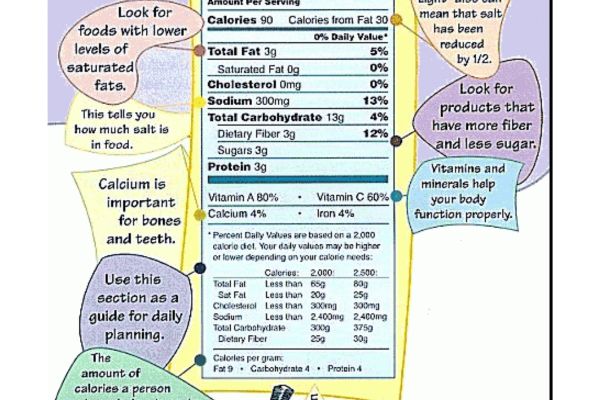
The Importance of Nutrition for Baby
It is difficult to exaggerate the significance of diet for infants. Infants grow and develop quickly in the first few years of life, therefore a healthy diet is essential to their general health and well-being. Sufficient nourishment fosters appropriate growth, fortifies the immune system, supports healthy brain development, and establishes lifelong eating habits.
Parents have several difficulties when it comes to selecting the best baby food. The process can be intimidating, from sorting through the many products on the market to understanding complicated nutrition labels. However, ensuring babies get the necessary nutrients to grow requires making educated decisions about baby food. Let us delve into 7 tips on how to read nutrition labels for baby food.
The Vital Role of Early Nutrition in Infant Development

Few duties in the path of parenthood are as significant and urgent as looking after a newborn’s health and well-being. Of all the factors, none is more important than diet from an early age. It is crucial to give a child a healthy diet throughout their early years of development. It establishes the framework for lifetime health, cognitive development, and physical growth. This article explores early nutrition’s significant influence on a child’s growth and health, emphasizing how it affects many facets of a child’s life.
Critical Phases of Growth and Development: The early years are a time of growth and development that cannot be matched. Infants experience a rapid progression of developmental milestones, both physical and cognitive, beginning at birth. Every vitamin, mineral, and nutrient is vital to support the body’s expanding requirements. Adequate nutrition becomes critical to support these transforming processes, as newborns undergo tremendous brain growth and within the first several months double their birth weight.
Needs for Nutrients: Compared to adults, infants have different nutritional requirements. For their little bodies to flourish, the right ratio of nutrients must be provided. Protein, carbs, lipids, vitamins, and minerals are among the essential ingredients that are necessary not only for growth but also for the development of tissues, organs, and cognitive abilities. Providing breast milk, formula, and eventually complementary foods to meet these needs establishes the groundwork for optimum health and vigour.
Immune System Development: A newborn’s immune system is still developing, leaving it susceptible to diseases and infections. Having a healthy diet is essential for boosting their immunity because it gives them the nutrients, enzymes, and antibodies they need to fight off infections. In particular, breast milk offers a multitude of preventive elements that help protect infants from illnesses, making it nature’s ideal immune booster.
Cognitive Development: During infancy, the brain develops quickly, with neural connections forming at an incredible rate. This complex process is supported in large part by nutrition, which supplies the building blocks required for synaptic connections and neuronal growth. Crucial nutrients that impact learning, memory, and behavior later in life include zinc, iron, choline, and omega-3 fatty acids. These nutrients are particularly important for cognitive development.
Developing Nutritious Eating Practices: Lifelong eating habits are shaped by early food encounters. Healthy eating habits are shaped by exposing babies to a wide variety of flavors, textures, and nutrients during the weaning process. Parents are essential in creating a healthy eating environment for their children by encouraging a varied and nutrient-dense diet that develops a love of whole foods.
Preventing Health Problems: Adequate nutrition during infancy establishes the foundation for long-term health in addition to supporting growth and development immediately. Early nutrition may reduce the chance of developing obesity, diabetes, cardiovascular disease, and other chronic illnesses in later life, according to research. By starting babies off with a diet high in nutrients, parents may provide their children with the resources they need to live long, healthy lives.

Essential Nutrients for Optimal Growth and Development in Infants
An infant’s growth and development are particularly important throughout the first few years of life. Sufficient nutrition is crucial during this period to maintain the body and brain working properly. These processes are greatly aided by essential nutrients, which include vitamins, minerals, proteins, lipids, and carbs.
Proteins: The Components That Build Growth
A. Part in Development and Mend
1. Growth, repair, and upkeep of tissues and organs depend on proteins.
2. They supply the amino acids required for fresh cell production.
B. Protein Sources
1. An infant’s main sources of protein are breast milk and formula.
2. Pureed meats, dairy products, and legumes can be introduced to newborns as they grow.
Fats: Vital for the Development of the Brain
A. Value of Nutritious Fats
1. Fats offer a concentrated energy supply that is essential for quick development.
2. They are essential for the synthesis of cell membranes and the development of the brain.
B. Important Acids
1. Neuronal growth and cognitive function depend on omega-3 and omega-6 fatty acids.
2. Arachidonic acid (ARA) and docosahexaenoic acid (DHA) are especially crucial for the development of the brain and eyes.
C. Healthy Fat Sources
1. Essential fatty acids are found in breast milk by nature.
2. DHA and ARA are frequently used to fortify formula.
3. Full-fat dairy, fatty seafood, and avocado can be introduced when babies start eating solid foods.
Carbohydrates: The Main Source of Energy
A. The Function of Sugars
1. Growing newborns get most of their energy from carbohydrates.
2. They promote both physical exercise and brain function.
B. Different Carbohydrate Types
1. Simple carbs give you energy quickly.
2. Complex carbs promote intestinal health and provide a steady supply of energy.
C. Carbohydrate Sources
1. Lactose is a simple carbohydrate that is found in breast milk and formula.
2. Fruits, vegetables, and whole grains become significant sources as solids are introduced.
Vital Micronutrients: Vitamins
A. Vitamin A
1. Vital for healthy skin, eyesight, and immune system.
2. Found in orange-colored foods like carrots and sweet potatoes, as well as breast milk and reinforced formula.
B. Vitamin D1. Essential for calcium absorption and bone health.
2. Synthesised by exposure to sunshine; also present in supplements and enriched formulas.
C. Vitamin C1. Critical for collagen synthesis and the immune system.
2. Found in fruits like oranges and strawberries, as well as breast milk and formula.
D. B vitamins
1. Encourage the generation of energy, brain growth, and red blood cell formation.
2. Present in a range of foods, such as whole grains, meats, breast milk, and formula.
Minerals: Promoting the Health of Bone and Muscle
A. Calcium
1. Important for the growth of healthy teeth and bones.
2. Present in dairy products, breast milk, and formula.
B. Iron
1. Essential for preventing anaemia and forming haemoglobin.
2. Found in meats, beans, fortified cereals, and breast milk.
C. Zinc 1. Essential for immunological response, wound healing, and growth.
2. Found in meats, whole grains, breast milk, and formula.
7 Tips on How to Read Nutrition Labels for Baby Food
It might be daunting for parents to navigate the infant food aisles. With so many alternatives available, it’s important to read nutrition labels to be sure your kid is getting the greatest nourishment possible. In order to help parents make educated food decisions for their infant, this article offers seven crucial pointers for properly interpreting nutrition labels.
Serving sizes set the provided nutritional facts in context
Standardised portions known as serving sizes let you compare the nutritional content of various goods. You can determine how much of each nutrient your baby will receive each serving by knowing the serving size.
For instance, the serving size for one jar of baby food may be listed as one jar (113 grammes), yet the serving size for another product may be listed as half a jar (56.5 grammes). Knowing this makes it easier to make sure the product comparisons you’re doing are correct.
Aids in precise comparison of various items
When evaluating various infant food brands, serving sizes are important to consider. They guarantee that the nutritional value you view is based on the same quantity, which simplifies the process of selecting the healthier option.
When a product’s serving size is greater, for example, it could seem like it contains more nutrients, but this could just be the case. Comparing items according to a standard serving size helps you determine which one offers superior nutrients for your baby.

Advice on Determining Serving Sizes
Make sure you always read the label’s serving size at the top.
The nutrition facts panel typically lists the serving size at the top. It indicates the quantity of food to which the nutritional data pertains.
For example, “Serving Size: ½ cup (120 ml)” or “1 jar (113 grammes)” could be written on the label. Because all of the nutritional values stated below are based on this precise amount, this information is essential.
You can be certain that you’re correctly interpreting the remaining nutritional information by regularly examining the serving size.
Verifying the Ingredients
A. The Value of Natural Substances
-Natural, basic components are usually better for your infant.
Improving nutrition is ensured by avoiding hazardous chemicals.
B. ii Hints for Evaluating Ingredients: Search for concise, easily understood ingredient lists.
Steer clear of meals that include artificial flavours, extra sugars, or preservatives.
Evaluating Carbohydrate Content
A. Important Nutrients for Infants: Give special attention to these nutrients, which include protein, carbs, fats, vitamins, and minerals.
– Make sure the infant food offers a well-rounded nutrition.
B. Tips for Evaluating Nutrient Quantities
– Pay attention to the percentages of daily values (DVs) for key nutrients.
– Look for foods rich in vitamins and minerals, especially iron, calcium, and vitamin D.
Being Aware of Allergens
A. Common allergies in Baby Food: Common allergies include fish, eggs, nuts, wheat, dairy, and soy.
– Being aware of allergens is essential, particularly if allergies run in the family.
B. A Guide to Recognising Allergens
– Check the ingredient list carefully for any possible allergies.
– Look for any label warnings about allergies.
Reducing Sodium and Added Sugars
A. Health Risks Associated with Excessive Sugar and Sodium Intake: Too much sugar can cause tooth issues and unhealthful weight gain. Hypersodium can impact renal function and blood pressure.
Advice for Cutting Sodium and Sugars: Look for labels that say “low sodium” or “no added sugars.”
– Watch out for hidden sugars, which are frequently labelled as fructose or corn syrup.
Examining Organic Choices
A. Advantages of Organic Baby Food: – Eating organic food may lower exposure to dangerous chemicals and pesticides. Frequently thought to be safer and more nutrient-dense.
B. Choosing Organic Advice:
Search for labels that are certified organic or bear the USDA Organic seal.
– Recognise that organic options could cost more, so weigh the advantages against the drawbacks.
Looking for Change
A. Dietary Diversity Is Important: Introducing a range of foods promotes the development of good eating practices.
– Assures a balanced consumption of various nutrients.
B. Advice for Providing a Variety of Foods: Switch up your baby’s diet by introducing new flavours and textures.
– Seek for fruit or vegetable combinations that have a variety of ingredients.
Evaluating the Nutrient Content
Protein: An essential component of growth and development, protein aids in tissue construction and repair. Seek for infant formulas that include fish, poultry, meat, beans, and legumes.
Energy primarily derived from carbs. Carbs are needed in foods including cereals, fruits, and vegetables.
Fats: Vital for energy and brain development. Breast milk, formula, avocados, and full-fat dairy products are examples of healthy sources.
Minerals and Vitamins
Iron: Essential for preventing anaemia and fostering cognitive growth. found in meat, green leafy vegetables, and fortified grains.
Calcium is necessary for the development and growth of bones. found in several vegetables, dairy products, and fortified plant milks.
Vitamin D: Promotes healthy bones and the absorption of calcium. accessible by eating foods supplemented with iron and limiting sun exposure.
Additional Vitamins: Fruits, vegetables, and fortified foods provide a range of vitamins (A, B, C, E, and K) that promote general health and development.
Balanced Diet: To guarantee a well-rounded diet, make sure the baby food contains a variety of these vital elements. In order to meet dietary demands and encourage healthy growth, variety is essential.
Advice for Calculating Daily Values (DVs) for Nutrient Quantities
Look for percentages of daily values (DVs) on the nutrition label to find out how much of each nutrient the item contains in relation to daily needs.
Choose foods that provide high percentages of the Daily Values (DVs) for important nutrients such as vitamins, calcium, and iron.
Packed with Minerals and Vitamins:
Give natural or fortified infant foods high priority if they contain important vitamins and minerals.
Foods rich in calcium, vitamin D, and iron are especially crucial for the growth and development of newborns.
Being Aware of Allergens
A. Typical Allergens and Common Allergens in Baby Food
Dairy, soy, wheat, eggs, nuts, and fish are common allergies.
It’s important to be aware of these possible allergens, particularly if allergies run in the family.
Allergy History in the Family:
When introducing new foods, exercise additional caution if allergies run in the family. To create a safe introduction strategy, confer with a paediatrician.
Guide to Recognising Allergens in Reading Lists of Ingredients
Always carefully review the ingredient list on food packages for infants. See whether any common allergies are mentioned.
Since the ingredients are listed by weight in descending order, allergies may be present in even minute amounts.
In order to make sure your kid is getting the finest nutrition possible, you must know how to read the nutrition labels on baby food. You may make decisions that promote your baby’s health and development by paying attention to serving sizes, ingredient lists, added sugars, sodium content, nutritional claims, vitamins and minerals, and allergen information. You can select items that support a healthy, balanced diet and stay away from potentially dangerous ingredients by taking the time to properly read these labels. In summary, being a watchful and knowledgeable consumer enables you to give your child the healthiest start possible, supporting their development and well-being.